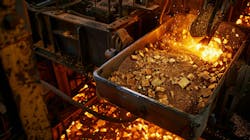President Trump’s Talk About Copper Tariffs Sparks Record Surge in COMEX Prices
President Trump’s announcement on July 8 that he intends to slap a 50% tariff on copper imports sent shock waves through the electrical market and roiled Comex copper futures.
In a note to subscribers of The Copper Journal, John Gross, publisher, and one of the nation’s leading experts on copper pricing said the announcement “triggered a record high 66¢, or 13% jump in the spot price of copper on Comex, which brought the market to a record high close of $5.65 per pound.”
“The global copper market has been in disarray for several months due to the threat of a 25% tariff on copper imports that was made in February,” he said in that note. “It is imperative that the administration lay out the details of how tariffs will be imposed and also announce the results of their investigation into imports of copper as they relate to national security. Until this is done, the global copper market will remain dangerously volatile.”
While the exact timing and percentage of the copper tariffs were not finalized at press time, their impact on the electrical wholesaling industry and — in particular the wire and cable market — cannot be understated. According to Electrical Marketing estimates, wire and cable accounts for 13% of the estimated $152.3 billion in electrical product sales for distributors — $19.6 billion.
Copper pricing had already seen record highs earlier this year of over $5 per pound before any discussion of tariffs. It first topped $5 per pound on March 18, 2025 and rose to a record $5.24 per pound on March 26, according to data at www.macrotrends.net. but it’s still up well over +30% per pound from the previous record at press time.
While the Trump Administration wants to implement these copper tariffs to encourage U.S. mining companies to develop more copper mines stateside, the reality is that copper mines take years to ramp up.
A report from S&P Global said on average it takes a new copper mine 2.4 years to come online from construction to start up. In addition, the study says it can take 1.4 years to finalize the construction decision. S&P also said the discovery, exploration and testing phase before construction takes on average 12.4 years.
A report at www.bbc.com cited data from the U.S. Geological survey that last year the United States imported about 810,000 metric tons of refined copper last year, about half of what it consumed. A July 8 Bloomberg report said Chile would be the most affected producer by the tariffs because it accounts for about 500,000 metric tons of the total of 700,000 tons of refined metal the United States imports a year. Bloomberg said Chile’s state-owned Codelco alone ships about 350,000 tons to the United States.
The impact of any new copper tariffs on the wire and cable market would drive up the cost of many construction projects. Implementation of these tariffs would seem sure to affect the expansion and renovation of the U.S. electrical grid, electric-vehicle charging stations and construction millions of square feet of new data centers, because of their insatiable appetite for the red metal.
It’s no wonder that John Mothersole, a noted economist with decades of experience tracking the pricing of copper and other metals for S&P and IHS used to call copper forecasting “the bane of my existence,” because of the difficulty in predicting the impact of global factors like labor strikes, fires or floods that shut down copper mines and the lack of reliable data on the amount of copper China stockpiles in Shanghai warehouses.
About the Author
Jim Lucy
Editor-in-Chief
Over the past 40-plus years, hundreds of Jim’s articles have been published in Electrical Wholesaling and Electrical Marketing newsletter on topics such as the impact of new competitors on the electrical market’s channels of distribution, energy-efficient lighting and renewables, and local market economics. In addition to his published work, Jim regularly gives presentations on these topics to C-suite executives, industry groups and investment analysts.
He launched a new subscription-based data product for Electrical Marketing that offers electrical sales potential estimates and related market data for more than 300 metropolitan areas, and in 1999 he published his first book, “The Electrical Marketer’s Survival Guide” for electrical industry executives looking for an overview of key market trends.
While managing Electrical Wholesaling’s editorial operations, Jim and the publication’s staff won several Jesse H. Neal awards for editorial excellence, the highest honor in the business press, and numerous national and regional awards from the American Society of Business Press Editors. He has a master’s degree in Communications and a bachelor’s degree in Journalism from Glassboro State College, Glassboro, N.J. (now Rowan University).


